This post is adapted from the blog of Perfect Price, a Priceonomics customer. Does your company have interesting data? Become a Priceonomics customer.
***
Comedians have made a habit of poking fun at Whole Foods. The grocery store’s reputation for high prices and stereotypes about its clientele have been the focus of many talk show routines and stand-up specials. As it turns out, selling $6 asparagus water makes you a pretty easy target. Conan O’Brien particularly loves to lampoon the store:
Whole Foods has started selling rabbit meat. They’re killing them humanely; they’re only using rabbits who died of shock after seeing the prices at Whole Foods.
Whole Foods, undoubtedly, is expensive. But when we step back and look at the average total cost per visit, is it really where Americans spend the most on grocery shopping?
Our curiosity about grocery shopping bills inspired us to analyze data on the the typical amount spent at the most popular stores in the United States. For this analysis, we used data from Perfect Price, a company that maintains a database of billions of credit card transactions. This data allowed us to understand exactly how much people spend when they go to different stores.
The table below shows the average amount of money spent per trip at the top food sellers in the United States. We included all food sellers in the top 25 of all retailers in terms of revenue, as well as a couple of other notable chains (like Trader Joe’s and Seven Eleven). For each of these stores, Perfect Price data includes thousands of trips in May and June of 2015. Though food items make up a large proportion of spending at all of these stores, they all sell non-food items to varying degrees.
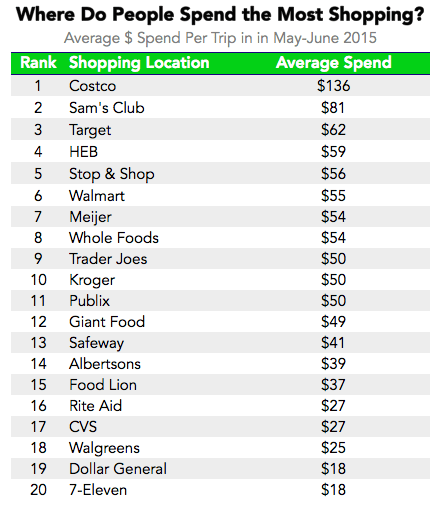
Source: Perfect Price
Far and away, consumers spend the most at Costco, the third largest retailer in the United States. It’s no surprise to see Costco at the top of the list. As a wholesaler, the company offers low unit prices in exchange for consumers purchasing in bulk. You can’t just buy one pack of Oreos at Costco — you have to buy ten. Costco is followed distantly by Sam’s Club, its primary wholesale competitor.
At the very bottom of the list is 7-Eleven, the largest convenience store chain in the United States. The average spend per trip at 7-Eleven is less than 15% of that at Costco. In fact, almost half of all purchases at 7-Eleven are for less than ten dollars. The chart below shows the percentage of purchases at each store of ten dollars or less. Interestingly, almost 10% of Costco purchases are less than $10 buys (perhaps Costco food court lovers?).
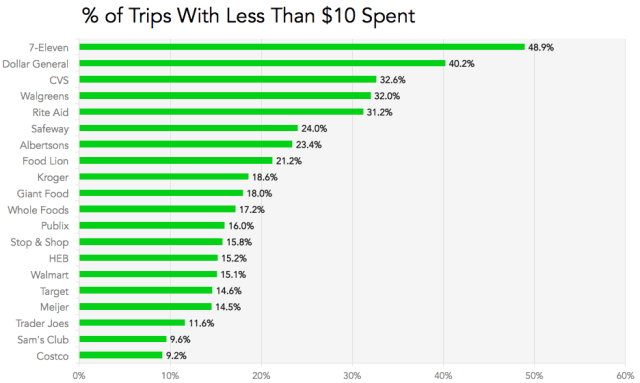
Source: Perfect Price
The average spend for trips to Walmart, Whole Foods and Trader Joe’s all fall in the range of $50-$55. We were interested in just how similar the distribution of bills were at these stores, and how they compared to Costco. Below, we parse out the percentage of purchases that fall into different spending categories: $0-$10, $10-$25, $25-$50, $50-$100, $100-$200, and over $200.
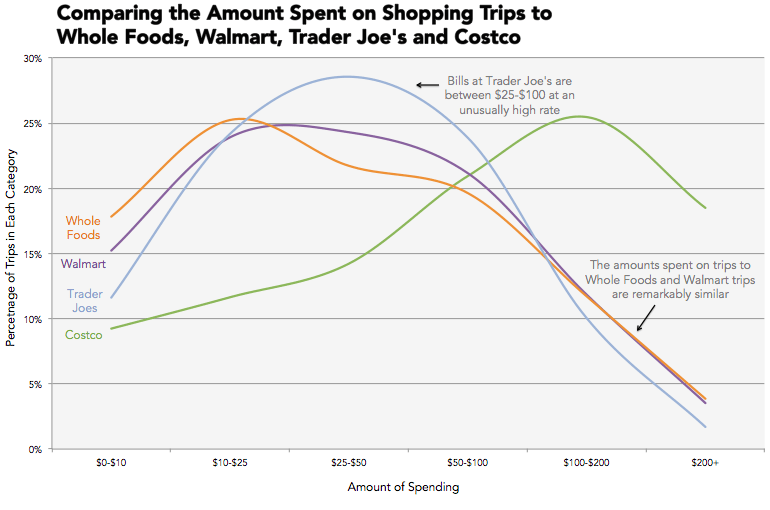
Source: Perfect Price
The distribution of spending at Whole Foods and Walmart — stores that are diametrically opposed in the cultural imagination — are actually quite similar in terms of the distribution of spend. Slightly more people spend less than $25 on a trip to Whole Foods, and slightly more spend between $25-$100 at Walmart, but overall, the distribution of how much people spend on trips to these stores are remarkably alike. Of course, Whole Foods prices are generally much higher than at Walmart, so this similarity is primarily a function of people making smaller trips to Whole Foods.
Trader Joe’s shoppers are heavily concentrated in the $10-$100 range with nearly 9 out of every ten falling in the category. People making trips to Trader Joe’s rarely spending very little, but are also unlikely to be going on a shopping spree. In contrast, Costco shoppers go big at an unusually high rate. Nearly 20% of trips to Costco are for bills of $200 or more. This is true of less than 5% of trips to Whole Foods, Walmart and Trader Joe’s.
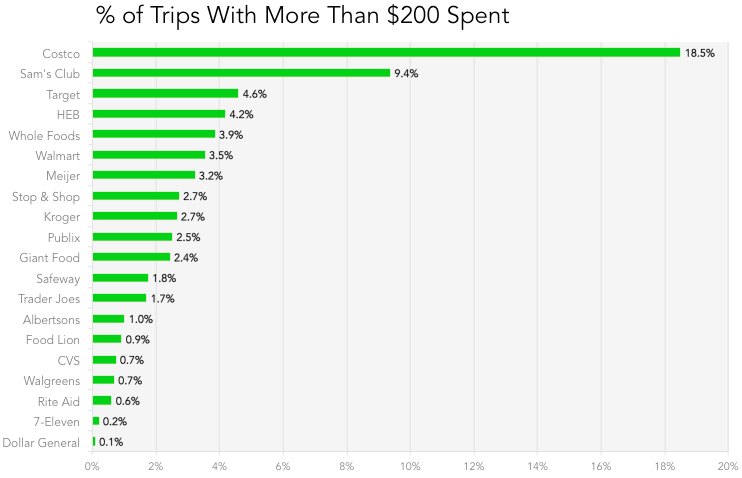
Source: Perfect Price
Given the impassioned feelings Whole Foods incites, we were intrigued about how spending differed at the store across cities. Were there certain cities where Whole Foods bills were unusually high? The next table shows the average spend in the twenty cities with the most shopping trips. What we found surprised us.
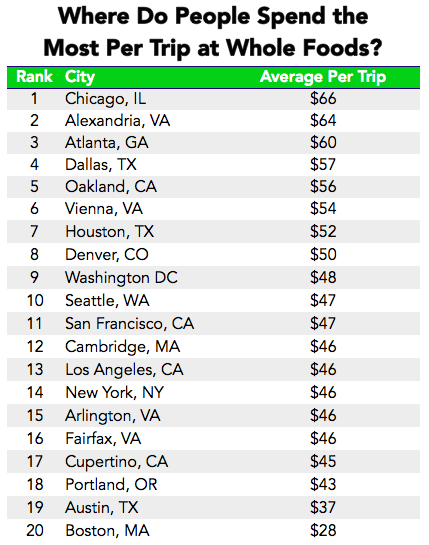
Source: Perfect Price
The city with the highest spending per trip is Chicago with an average of $66. This is more than double what we found for trips in Boston, and 50% more than trips in Austin and Portland. Boston, Austin and Portland, the places with the lowest Whole Foods spend per trip, are all places where Whole Foods stores are abundant. Making a trip to Whole Foods in these cities is less of a hike for people in these cities, so they are more likely go for a smaller trip.
It has been nearly a century since grocery shopping, in its modern self-serve form, emerged. It used to be that a clerk personally collected whichever items shoppers requested. Today, stores of all shapes and sizes have materialized to meet Americans’ shopping needs. And as we’ve seen here, what we spend at those stores — from Whole Foods to Costco to 7-Eleven — varies tremendously.
***
In our next post, we analyze the last words of death row inmates. To get notified when we post it → join our email list.




